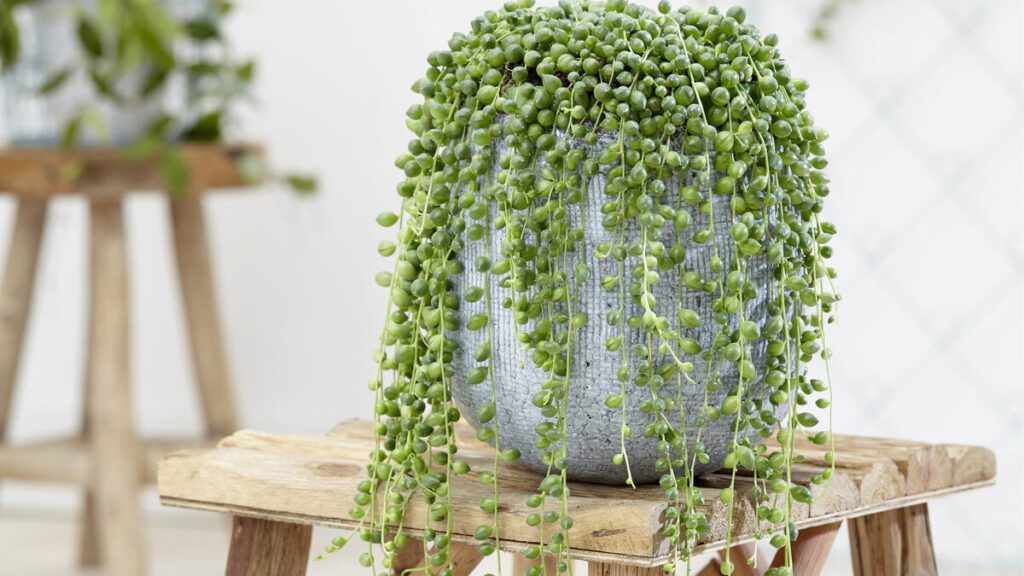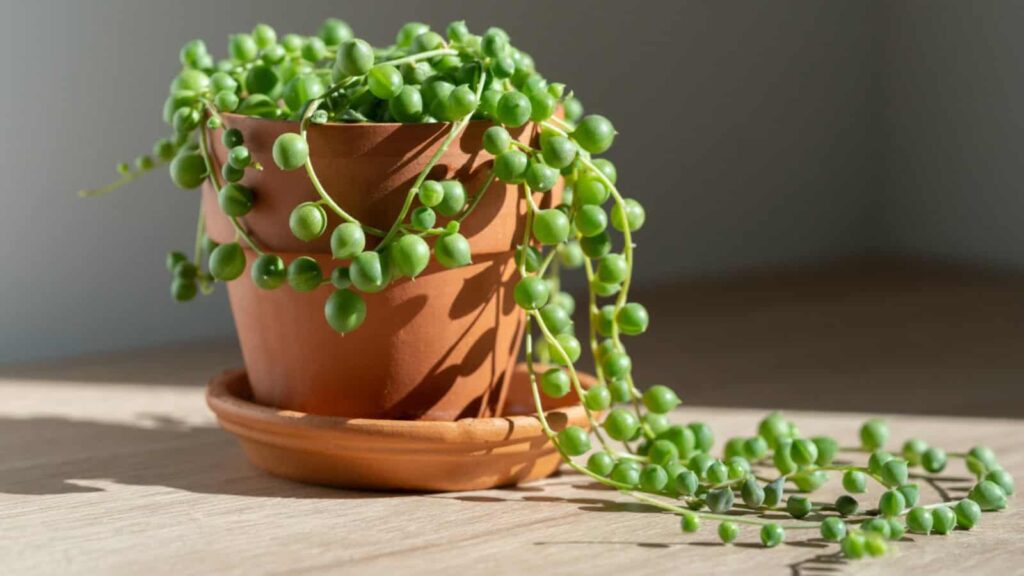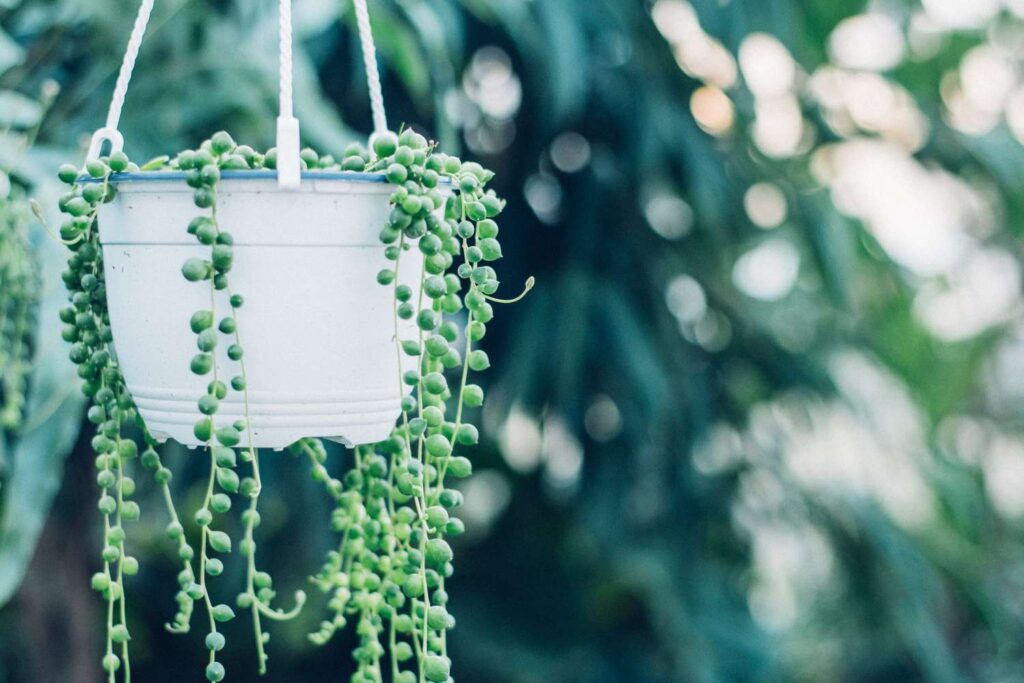In the vast world of botanical wonders, the “String of Pearls” plant stands out as a unique and captivating specimen. Known for its towering vines adorned with rounded, bead-like leaves, this lush plant has become a favorite among plant enthusiasts and interior decorators alike. In this article, we will explore the attractive features, care tips, and cultural significance of the String of Pearls plant.
String of Pearls Plant
The String of Pearls plant, with its adorable appearance and easy care requirements, has made its place as a beloved succulent plant among plant lovers. Whether you’re attracted to its unique beaustring of pearlsty, cultural symbolism, or compatibility with modern design trends, incorporating this botanical gem into your living space can add a touch of natural beauty and charm. By understanding its growth habits, care needs, and cultural significance, you can cultivate a rich string of pearls and enjoy the timeless beauty it brings to your home.

How to Propagate String of Pearls
Botanical Overview
The string of pearls, scientifically known as Senecio rowleyanus, is a member of the Asteraceae family. Originating from the dry regions of south-west Africa, this succulent plant earned its nickname due to the distinctive appearance of its trailing stems, which resemble a string of small, green beads. The plant’s unique growth pattern and aesthetic appeal make it a popular choice for those who want a touch of nature in their living space.
Physical Characteristics
The String of Pearls plant has long, trailing stems that can reach three feet in length. The small pearl-like rounded leaves are usually green, but some varieties may exhibit subtle variations in color ranging from silver to blue or purple. The leaves are juicy, which allows the plant to store water efficiently, making it well-adapted to dry conditions.
Growth Habit and Care Requirements
String of Pearls is a relatively low-maintenance plant, making it suitable for both novice and experienced plant enthusiasts. It thrives in well-drained soil, preferably a cactus or succulent mix, and requires ample sunlight. However, it is important to protect the plant from intense, direct sunlight, as this can cause sunburn on the delicate leaves.
Another important aspect of rosary pearl care is watering. As a succulent, it is important to allow the soil to dry out between watering to prevent root rot. Overwatering is a common mistake, so a light touch is recommended. During the growing season (spring and summer), regular fertilization with a diluted, balanced fertilizer can promote healthy growth.
Popular Varieties
While the classic green string of pearls is widely recognized, there are many captivating varieties that add variety to this beloved succulent family.
Variegated String of Pearls
Different varieties have leaves with unique patterns, often displaying stripes or marbled designs. The variety adds an extra layer of visual interest to the plant, making it a favorite choice for collectors.
String of Pearls ‘Curio Rowleyanus
This variety is a more compact version of traditional beadwork, making it suitable for smaller spaces or containers. Its small size does not compromise its charm, as the pearls still hang beautifully from the cascading stems.
String of Pearls ‘Blue Chalksticks’
This variety displays blue-green leaves, providing a refreshing departure from the classic green color. The ‘Blue Chopsticks’ variety is a great choice for those who want to add a subtle but distinctive color to their plant collection.

Care Tips and Maintenance
Ensuring the well-being of your String of Pearls plant involves a combination of proper care, attention, and occasional maintenance.
Light Requirements
String of pearls plants thrives in bright, indirect light. Although they can tolerate some direct sunlight, it is important to protect them from strong afternoon sun, as excessive exposure can scorch the delicate leaves. Placing them near a south or west-facing window with filtered sunlight is ideal.
Watering Guidelines
Proper watering is key to the health of your string of pearls. Allow the soil to dry completely between watering, and be careful not to let water collect in the saucer at the bottom of the pot. During the winter dormant period, reduce the frequency of watering to prevent overhydration.
Soil and Potting
It is important to use a well-draining soil mix to prevent waterlogging of the roots. Cactus or succulent mix, combined with perlite or sand, helps maintain the right balance of moisture. Replanting may be necessary every 2-3 years to refresh the soil and provide additional space for the plant.
Pruning and Propagation
String of Pearls plants are relatively easy to propagate. Cuttings can be taken from healthy stems, and after placing the cut ends in a callus for a day or two, they can be planted in a new container. Regular pruning can help maintain the plant’s shape and control its size, ensuring a lush and attractive appearance.
String of Pearls in Cultural Context
Apart from its botanical appeal, the String of Pearls plant has cultural significance in various traditions and beliefs.
Symbolism
The cascading beads of a string of pearls are often associated with the concepts of abundance, prosperity and good fortune. In some cultures, it is believed that displaying this succulent brings good luck and positive energy to the home.
Feng Shui
In Feng Shui, the arrangement and placement of objects within a space are believed to affect the flow of energy (chi). String of Pearls, with its trailing vines and round leaves, is considered an auspicious plant that attracts positive energy and abundance when placed in specific areas of the home or office.
String of Pearls in Contemporary Design
There has been a resurgence in popularity of the String of Pearls plant in recent years, becoming a staple in contemporary interior design.
Aesthetic Appeal
The plant’s unique form and trailing vines make it an attractive addition to any space. Its ability to thrive in hanging baskets or decorative containers allows for versatile placement, whether hanging from the ceiling or adorning shelves and tabletops.
Compatibility with Modern Aesthetics
The minimalist and modern aesthetics prevalent in today’s interior design trends go well with string beads. Its smooth, trailing vines complement the clean lines and uncluttered spaces, adding a touch of nature without overwhelming the overall design.

Common Challenges and Solutions
While String of Pearls is a resilient plant, it can face some challenges that require attention and care.
Pests
Common pests such as aphids and mealybugs can affect String of Pearls. Regular inspection and, if necessary, treatment with neem oil or insecticidal soap can help keep these troubles at bay.
Overwatering
One of the most common problems with this succulent plant is overwatering, which can lead to root rot. This problem can be prevented by adjusting the frequency of watering and ensuring proper drainage in the soil.
Leggy Growth
If the plant becomes excessively leggy or loses its compact shape, pruning is recommended. Pruning the stems back will encourage bushy growth and maintain a more attractive appearance.
FAQs
What is a String of Pearls plant?
Ans: The String of Pearls plant, scientifically known as Senecio rowleyanus, is a succulent native to southwestern Africa. It is famous for its trailing stems adorned with rounded, bead-like leaves, which give it a distinctive and charming appearance.
How do I care for my String of Pearls plant?
Ans: String of Pearls plants thrive in well-drained soil and bright, indirect light. Allow the soil to dry out between watering and be careful of overwatering to prevent root rot. Regular pruning can help maintain its shape, and occasional fertilization during the growing season is beneficial.
Can I grow a String of Pearls plant indoors?
Ans: Yes, String of Pearls is suitable for indoor cultivation. Make sure it gets bright, indirect light and protect it from intense, direct sunlight. It is a great choice for hanging baskets, decorative containers or as a trailing element in your indoor garden.
What are the different varieties of String of Pearls?
Ans: There are many varieties of String of Pearls, including the classic green variety, varieties with unique leaf patterns, and compact varieties such as ‘Curio Rowleyanus’. ‘Blue Chopsticks’ is another variety with attractive blue-green leaves.
How often should I water my String of Pearls?
Ans: The frequency of watering depends on factors such as temperature and humidity. Allow the soil to dry completely between watering, especially during the winter dormant period. Overwatering should be avoided to prevent root rot.
Can I propagate my String of Pearls?
Ans: Yes, String of Pearls is relatively easy to propagate. You can take cuttings from healthy stems, leave the cut to callus for a day or two, and then plant them in a new container with well-drained soil.
Are there any common pests that affect String of Pearls?
Ans: Yes, common pests include aphids and mealybugs. Inspect your plant regularly, and if necessary, treat it with neem oil or insecticidal soap to keep these pests under control.
What is the significance of the String of Pearls in different cultures?
Ans: Strings of pearls are often associated with the concepts of abundance, prosperity and good fortune. In Feng Shui, it is considered an auspicious plant that attracts positive energy and wealth when placed in specific areas of the home or office.
Can the String of Pearls plant be grown outdoors?
Ans: Yes, String of Pearls can be grown outdoors in mild climate areas. Make sure it is planted in well-drained soil and receives partial shade to protect it from hot sun.
How can I prevent my String of Pearls from becoming leggy?
Ans: If your plant becomes excessively leggy, regular pruning is recommended. Prune the stems back to encourage bushier growth and maintain a more attractive appearance.

